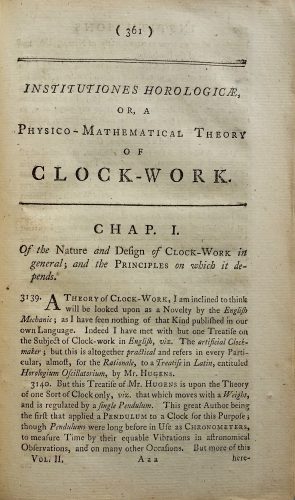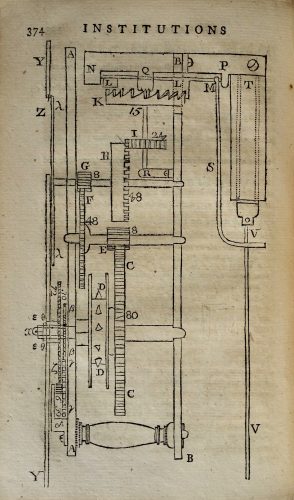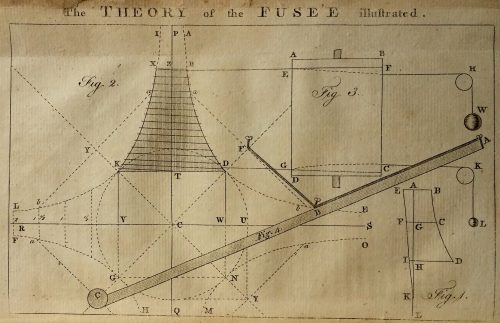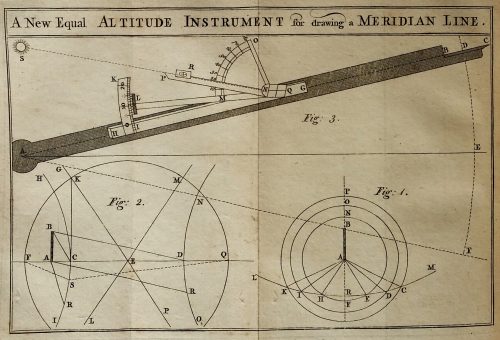
Title page of Institutiones Horologicae
Institutiones Horologicae, or, A Physico-Mathematical Theory of Clock-Work is a little known work by Benjamin Martin being the horological section of a much larger work printed in London for W. Owen, at Homer’s Head near Temple Bar, Fleet Street.
The book, published in 1764, is about the mathematical and physical principles of clockwork and how to calculate gear trains; the theory of pendulums and balance springs; the principles of celestial mechanics applied to the construction of planetariums, lunariums, etc; an explanation of the equation of time; and the theory and construction of sundials.
Benjamin Martin (note 1) is an interesting character, he was self-educated and his first profession was as a schoolmaster. Later he became a well known travelling lecturer and author making the new science of experimental philosophy popular in eighteenth century Britain. In 1756 he started an instrument making business in Fleet Street, London and was a successful retailer of scientific instruments. His publications, including The General Magazine, publicised and promoted his business.
Martin published his major work The General Magazine of Arts and Sciences, Philosophical, Philological, Mathematical, and Mechanical: … in monthly sections issued between 1755 and 1765 priced at sixpence per month. Title pages and indices for binding were issued when each part was complete. Part IV of the General Magazine, in two volumes, was completed in 1764 and has the title A New and Comprehensive System of Mathematical Institutions, Agreeable to the Present State of Newtonian Mathesis.. .
Institutiones Horologicae was the last section in volume 2 which explains why the page numbers run from 361 to 535 and it is sometimes found with the index to Part IV bound in at the end. The bibliographic aspects of this work have been covered in detail by John R. Milburn (note 2).

Drawing copied from Christian Huygens’ Horologium Oscillatorium of 1673
I have never seen a complete copy of the General magazine or of Part IV but as subscribers could bind the parts as they wished Institutiones Horologicae is sometimes found bound on its own (usually with the 5-page index to Part IV and a single sheet – one side with a list of 17 books sold by W. Owen, the other side with a priced list of Mathematical, Philosophical, and Optical Instruments, invented or improved, by B. Martin. )
The book contains a printing error in that pages 425 – 432 are incorrectly numbered 325 – 332. This did not cause the binders a problem as the book’s paragraphs are numbered sequentially.
The book has 12 folding plates, but for the two copies I have seen, 2 plates are on one sheet of paper so there are only 11 folding sheets of paper. Sadly some copies do not have a complete set of plates. For a complete list of plates see note 3.
Note 1)
John R. Millburn, ‘Benjamin Martin, Author, Instrument Maker, and “Country Showman”‘, Noordhoff International Publishing, Leyden, 1976.
Note 2)
John R. Millburn, ‘Martin’s Magazine: The General Magazine of Arts and Sciences, 1755 – 1765’, The Library, 5th series, 28 (1973) 221 – 239, and plates VII & VIII.

The Theory of the Fusee Illustrated
Note 3)
The 12 plates, which are not numbered and often bound in the wrong order, are listed below with a cross reference from the figures they contain to the first paragraph where the figure is mentioned.
The Theory of the Fusee Illustrated (best location facing page 361)
fig 1 paragraph 3153
fig 2 3157
fig 3 3164
fig 4 3170
The Theory of Springs and Pendulums (facing page 385)
fig 1 3233
fig 2 3235
fig 3 3238
fig 4 3247
fig 5 3269
fig 6 3272
fig 7 3279
fig 8 3289
fig 9 3302
fig 10 3305
fig 11 3307
The Universal Pendulum (facing page 416)
fig 1 3318
fig 2 3318 (& 3337 footnote)
fig 3 3343
fig 4 3357
fig 5 3373
fig 6 3407
The Theory of the Circulating pendulum, Oscillating Rotula, Etc. (facing 440)
fig 1 3423
fig 2 3433
fig 3 3434
fig 4 3438
fig 5 3442
fig 6 3449
fig 7 3452
fig 8 3457
fig 9 3465
fig 10 3470
New Pendulums of Different Kinds (facing 456)
fig 1 3486
fig 2 3501
fig 3 3508
fig 4 3513
fig 5 3522
fig 6 3526
fig 7 3529
fig 8 3537
fig 9 3538
The Principles of Celestial Mechanics (facing 469)
fig 1 3545
fig 2 3546
fig 3 3551
fig 4 3554
fig 5 3567
The Microcosm (facing page 477) para 3589
A Tellurian with Three Globes (facing page 484) * on same sheet as next plate
fig 1 3592
fig 2 3594
fig 3 3597
fig 4 3610
fig 5 3611
fig 6 3614
Mechanism for a Lunarium (facing page 484)
fig 1 3619
fig 2 3618
fig 3 3631
fig 4 3633
The Theory of the Equation of Time (facing page 500)
fig 1 3644
fig 2 3648
fig 3 3657
fig 4 3667
fig 5 3670
fig 6 3681
fig 7 3682
fig 8 3688
A New Equal Altitude Instrument for Drawing a Meridian Line (facing page 519)
fig 1 3701
fig 2 3704
fig 3 3716
The Theory of Elliptical, Circular, and Diametral Dials (facing 524)
fig 1 3719
fig 2 3736
fig 3 3742
fig 4 3758
fig 5 3755

A New Equal Altitude Instrument
